
Karol Mikuli, also known as Charles Mikuli was a Polish pianist, composer, conductor and teacher. His students included Moriz Rosenthal, Raoul Koczalski, Aleksander Michałowski, Jaroslaw Zieliński, Kornelia Parnas and Heinrich Schenker.
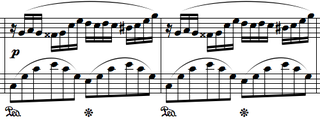
Frédéric Chopin's Fantaisie-Impromptu in C♯ minor, Op. posth. 66, WN 46 is a solo piano composition. It was composed in 1834 and published posthumously in 1855 despite Chopin's instruction that none of his unpublished manuscripts be published. The Fantaisie-Impromptu is one of Chopin's most frequently performed and popular compositions.
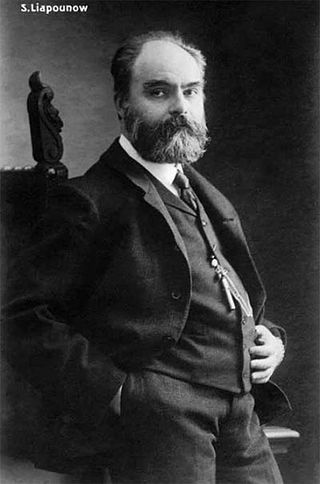
Sergei Mikhailovich Lyapunov was a Russian composer, pianist and conductor.

Józef Antoni Franciszek Elsner was a Polish composer, music teacher, and music theoretician, active mainly in Warsaw. He was one of the first composers in Poland to weave elements of folk music into his works.
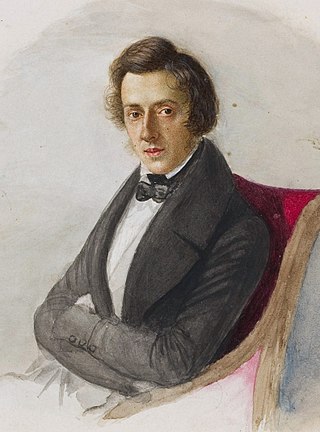
The Piano Sonata No. 2 in B♭ minor, Op. 35, is a piano sonata in four movements by Polish composer Frédéric Chopin. Chopin completed the work while living in George Sand's manor in Nohant, some 250 km (160 mi) south of Paris, a year before it was published in 1840. The first of the composer's three mature sonatas, the work is considered to be one of the greatest piano sonatas of the literature.
A-flat major is a major scale based on A♭, with the pitches A♭, B♭, C, D♭, E♭, F, and G. Its key signature has four flats.
B-flat minor is a minor scale based on B♭, consisting of the pitches B♭, C, D♭, E♭, F, G♭, and A♭. Its key signature has five flats. Its relative major is D-flat major and its parallel major is B-flat major. Its enharmonic equivalent, A-sharp minor, which would contain seven sharps, is not normally used.
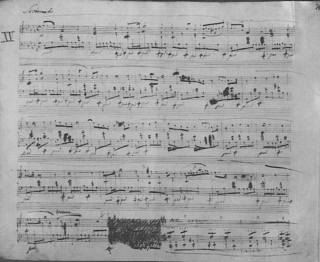
Frédéric Chopin wrote a number of preludes for piano solo. His cycle of 24 Preludes, Op. 28, covers all major and minor keys. In addition, Chopin wrote three other preludes: a prelude in C♯ minor, Op. 45; a piece in A♭ major from 1834; and an unfinished piece in E♭ minor. These are sometimes referred to as Nos. 25, 26, and 27, respectively.

The Piano Sonata No. 3 in B minor, Op. 58, is a piano sonata in four movements composed by Polish composer Frédéric Chopin; it is the second of the composer's three mature sonatas(the others being the Piano Sonata No. 2 in B-flat minor, Op. 35, and the Sonata for Piano and Cello in G minor, Op. 65). Completed in 1844 and published in 1845, the work is considered to be one of Chopin's most difficult compositions, both technically and musically. The work has a structure similar to Piano Sonata No. 5 in F Sharp Minor, Op. 81 by Johann Nepomuk Hummel. A performance of the sonata lasts around 23 to 30 minutes, depending on whether the repetition of the exposition in the first movement is observed. The work is dedicated to Countess Élise de Perthuis.
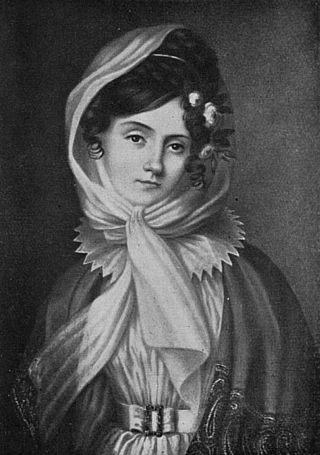
Maria Szymanowska was a Polish composer and one of the first professional virtuoso pianists of the 19th century. She toured extensively throughout Europe, especially in the 1820s, before settling permanently in St. Petersburg. In the Russian imperial capital, she composed for the court, gave concerts, taught music, and ran an influential salon.
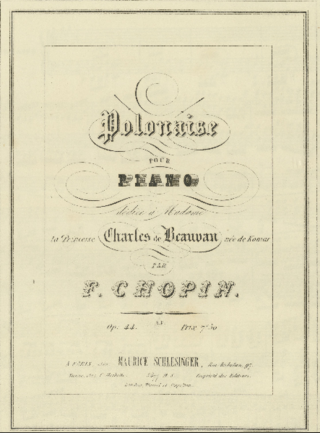
The Polonaise in F-sharp minor, Op. 44, is a piece for solo piano written by Frédéric Chopin in 1841. It is often referred to as the "tragic" polonaise, due to its dark nature. The polonaise is dedicated to Princess Ludmilla de Beauvau, a prominent member of the Polish émigré community in Paris.
The Mazurkas, Op. 6 are Frédéric Chopin's first set of mazurkas published during his lifetime. They were composed in 1830–1831 and were published in 1832. The set was dedicated to Grafin Pauline Plater.
The Rondo in C minor, Op. 1, for solo piano is Chopin's first published work, published in 1825, and dedicated to "Madame de Linde", the wife of the headmaster of the Lyceum at which Chopin was studying. The piece contains an "unorthodox tonal scheme". The first phase begins in C minor, moving into E major, A♭ major, then back to C minor. The second phase moves to D♭ major, finishing in C minor for a final statement of the theme.
Over the years 1825–1849, Frédéric Chopin wrote at least 59 compositions for piano called Mazurkas. Mazurka refers to one of the traditional Polish dances.

Mazurkas, Op. 17 is a set of four mazurkas for solo piano by Frédéric Chopin, composed in 1832–1833 and published in 1834. The set was dedicated to Lina Freppa.
The Mazurkas, Op. 7 are a set of five mazurkas by Frédéric Chopin. The mazurkas were mostly written in 1830–1831 and were published in 1832. This is the only set of Chopin's mazurkas that contains 5 pieces; all the composer's other published sets consist of either 3 or 4 mazurkas each. It is dedicated to Paul Emile Johns.










